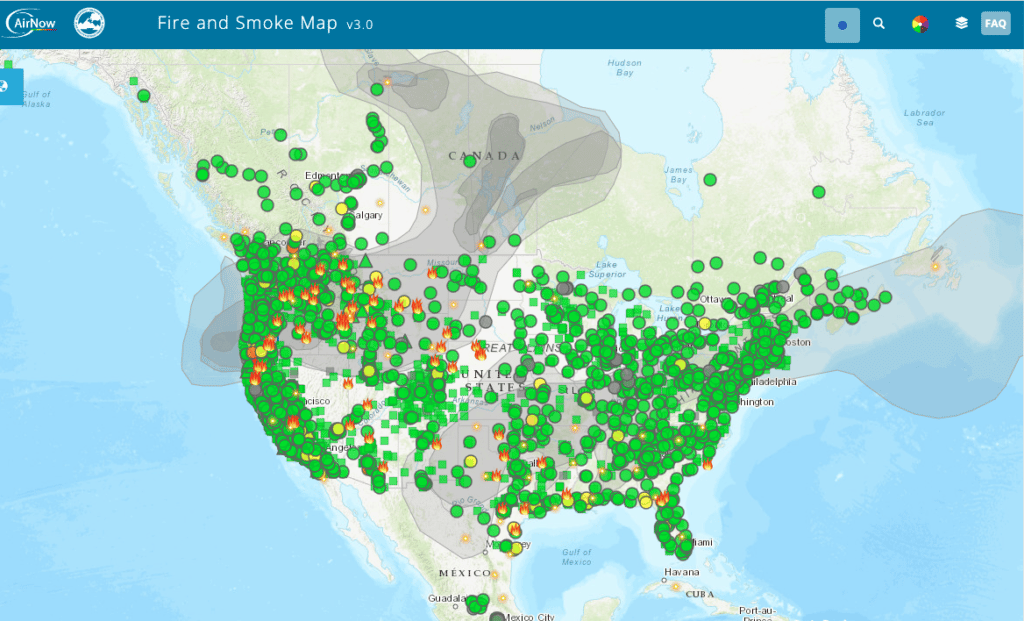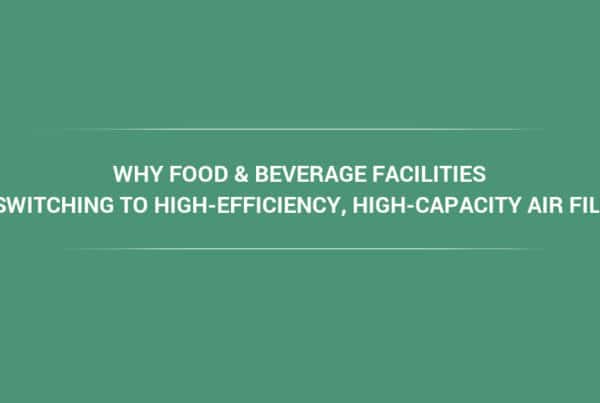How to Improve Indoor Air Quality in Areas Affected by Wildfires
Wildfires are usually at their peak July through October. This year is no exception. More than 5.7 million acres of woodland have already burned according to the National Centers for Environmental Information[1] (NCEI)’s Interagency Fire Center – the third most in recorded history. Summer droughts, reduced mountaintop snowpack and lightning strikes have doubled the area of wildfires in the western U.S.
Does wildfire smoke affect air quality?
Yes. Wildfires cause poor air quality, which affects the health of people both indoors and outside. This is because wildfires produce tiny dangerous airborne particles and gaseous contaminants regulated by the EPA’s National Ambient Air Quality Standards (Clean Air Act)[ii].
When wildfire smoke is drawn into a building through an HVAC system without proper filtration, the contaminants can spread throughout the facility, causing poor air quality conditions. Patients and visitors in hospitals, outpatient or residential care facilities are especially vulnerable to these contaminants.
Why wildfire smoke is a health concern
Breathing wildfire smoke is bad for the body. PM2.5 contaminants (particles smaller than 2.5 microns) can penetrate deep into the lungs and bloodstream. Molecules of gases like ozone are thousands of times smaller than PM2.5 particles, and are able to enter the body’s cells and major organs, causing irreversible damage.
Exposure to pollutants from wildfire smoke increases the likelihood of contracting and experiencing severe complications. PM2.5 and gaseous contaminants cause a range of health problems from temporary burning eyes to lifelong heart and lung damage. That is why the EPA refers to ozone as “sunburn for the lungs.”[iii]
Programs such as the Interagency Wildfire Air Quality Response Program were created to directly assess, communicate, and address risks posed by wildland fire smoke to public health [iv]. However, the most important tool to gauge exposure risk is the Air Quality Index (AQI).
What is the Air Quality Index?
The EPA created the AQI to help measure the level of pollutants in the air at any given time for each area of the United States. This index is now used around the world, with readings measured at every airport. Think of the AQI as a yardstick that runs from 0 to 500. The higher the AQI value, the greater the level of air pollution and the greater the potential health impact.
The AQI is divided into six categories. Each category corresponds to a different level of health concern. Each category also has a specific color. The color makes it easy for people to quickly determine whether air quality is reaching unhealthy levels in their communities.[v] Green (<50) and yellow (51-100) are acceptable, orange (101-150) means sensitive people may be affected, red (151-200) and purple (201-300) are enough cause for alarm that people should stay inside, and maroon (above 301) means emergency conditions are present.

To generate the AQI, the EPA measures the level of criteria air pollutants from the Clean Air Act – ground-level ozone, PM2.5, carbon monoxide, sulfur dioxide (SO2 ) and nitrogen dioxide (NO2) Gases are measured in parts per billion and particulates are measured in micrograms (µg) per cubic meter.
The EPA crunches all of these readings into a formula in order to generate the one AQI number that is reported on the above chart. Most sites like purpleair.com and airnow.gov will also tell you which component is causing the number to be high.
How wildfires affect AQI
Wildfire smoke contains pollutants because it is produced by the combustion of organic and other substances. The smoke contains microscopic particles less than 2.5 microns in size, known as PM2.5. In fact, 90% of the total mass of wildfire smoke is comprised of these particles and they are the largest contributor to a poor AQI number. Particles generally 2.5 µm in diameter or smaller represent a main pollutant emitted from wildfire smoke, comprising approximately 90% of total particle mass.[vi]
Wildfires also release gaseous hydrocarbons and nitrogen oxides that form nuisance odors and ground-level ozone. Ground-level ozone is created when UV light from the sun reacts with gases near the earth’s surface. Secondary contaminants from wildfires include:
- Nitrogen Oxides
- Sulfur oxides
- Carbon monoxide
- Unburned hydrocarbons
- Volatile organic compounds
The map below from AirNow.gov shows fire and smoke occurrences from August 8, 2022. Smoke can be carried on air currents to populated areas miles away from the actual fire. People in the midwest and east are not immune from the effects of fires burning hundreds of miles to the west or south. All of these contaminants can enter indoor spaces, causing poor indoor air quality for workers and visitors to facilities. It is typically a facility manager’s job to figure out how to reduce wildfire smoke exposure for employees and visitors to the buildings.

Filtering Wildfire Smoke (Cleaning the Air)
When considering wildfire smoke, the particulate matter is the first area to address with filtration. The PM2.5 particles need to be captured because those are what causes the greatest health problems. In addition, if the facility’s location is close to the source of the fire, there can be high levels of ozone gases and nuisance odors. In those cases, the gases need to be captured along with the particles. Even if the dangerous particles are captured, people don’t want to work or visit facilities that smell like smoke.
To mitigate the risks and nuisance of wildfire smoke, Camfil recommends using a combination of high efficiency air filters to capture PM2.5 particles and carbon filtration to control odor and gaseous contaminants.
Capturing PM2.5 Particulates
We recommend using a filter that will catch at least 90% of the PM2.5 particles. That means the filter should have a minimum efficiency reporting value (MERV) of at least 14A.
The “A” rating is important because it verifies the filters were tested according to ASHRAE Standard 52.2-2017 with Appendix J to test the efficiency after any electrostatic charge has been discharged. This test shows what the efficiency is over the entire lifetime of the filter, not just in the first few weeks. .
Capturing gases
Capturing the gases contained in smoke requires molecular filtration because the molecules are too tiny to be captured by particulate filters. For example, a .3 micron-sized solid particle would contain 1000 ozone molecules. Molecular filters use granulated carbon, which contain a vast network of pores to provide a huge surface area to collect the gas molecules as they make contact. . The molecules attach themselves to the surface of the pores by light intermolecular forces. This process is known as adsorption.
When selecting molecular filters, make sure your filter was tested to ISO 10121 (or ASHRAE 145.2) to validate its performance under actual process conditions. Since there are over 250 million chemicals that all behave differently, there is no molecular filter classification system like ASHRAE’s MERV valueThe only way to know for certain how the filter will work is to test it using the actual chemical and process conditions.
Camfil uses its ISO 10121 test rig in Trosa, Sweden and Ipoh, Malaysia to test gases at the correct concentrations, temperature and relative humidity level. The air is measured upstream and downstream to gauge performance. This validation testing can make a significant difference in actual use for two filters that claim the same efficiency. For example, Camfil’s MERV 14A particulate filters with a carbon layer maintain their 95% efficiency performance against ozone versus competitive filters that drop efficiency to 70% almost immediately.
Installing Filtration to Mitigate Wildfire Smoke
Camfil recommends installing 12” deep MERV 14A filters for PM2.5 and 12” high- capacity carbon filters for gas removal. If there are two filter banks, a Durafil MERV14A followed by a CitySorb DP (carbon) molecular filter is recommended. If there is only one filter bank, the facility should use a CityCarb I combination MERV 14A plus molecular (carbon) filter. ISO tests demonstrate that the CitySorb DP and Camfil CityCarb I filter have superior performance against ozone, nitrogen dioxide, sulfur dioxide and toluene which is used to represent smoke odors. Camfil encourages engineers to design tomorrow’s systems with two banks so that each filter can be utilized for its full lifetime.
Facilities can also use supplemental filtration indoors when wildfires are present. These air cleaners like the City M with HEPA and molecular filters and modular CamCleaner systems are commonly used in hospital waiting rooms, universities, offices, etc. to supplement the amount of air scrubbing in a space.
About Camfil Clean Air Solutions
For more than half a century, Camfil has been helping people breathe cleaner air. As a leading manufacturer of premium clean air solutions, we provide commercial and industrial systems for air filtration and air pollution control that improve worker and equipment productivity, minimize energy use, and benefit human health and the environment. We firmly believe that the best solutions for our customers are the best solutions for our planet, too. That’s why every step of the way – from design to delivery and across the product life cycle – we consider the impact of what we do on people and on the world around us. Through a fresh approach to problem-solving, innovative design, precise process control, and a strong customer focus we aim to conserve more, use less and find better ways – so we can all breathe easier.
The Camfil Group is headquartered in Stockholm, Sweden, and has 31 manufacturing sites, six R&D centers, local sales offices in 35+ countries, and about 5,200 employees and growing. We proudly serve and support customers in a wide variety of industries and in communities across the world. To discover how Camfil USA can help you to protect people, processes and the environment, visit us at www.camfil.us/.
[i]https://www.ncei.noaa.gov/access/monitoring/monthly-report/fire/202207
[ii] https://www.epa.gov/clean-air-act-overview
[iii]chrome-extension://efaidnbmnnnibpcajpcglclefindmkaj/https://www3.epa.gov/airnow/mediakits/ozone/ozone.pdf
[iv] https://www.wildlandfiresmoke.net/
[iv] https://www.airnow.gov/aqi/aqi-basics/
[v] Vicente et al. 2013; Groβ et al. 2013). (epa.gov)



